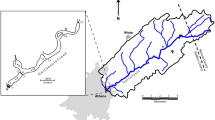Abstract
The persistence and biological impact of the organophosphorus insecticides, Abate®, Reldan®, and Dursban®, were studied following the application of 10 ppb to a series of artificial polyethylene-lined ponds and a single natural pond inoculated with leaf litter. Disappearance of the insecticides from water could be described in terms of two phases: early posttreatment, in which rapid partitioning took place; and, a variable time period, characterized by slowly decreasing residues. Of the three pesticides, Dursban was the most persistent followed by Reldan and Abate in that order.
The rapid initial disappearance of the pesticides from water was primarily attributable to adsorption on bottom sediments and polyethylene. Polyethylene appeared to have a greater affinity for the pesticides than did the sediments. However, desorption from the polyethylene contributed to residual concentrations in the water of artificial ponds for prolonged periods.
Dursban was most toxic to cladoceran and copepod populations. Cladocerans were more sensitive to the three insecticides than were cyclopod and calanoid copepods or copepod nauplii.
Chlorophyll concentrations as a measure of algal biomass were always greater in ponds treated with Abate or Dursban than in untreated ponds, supporting the conclusion that algal blooms result from the elimination of Zooplankton predation.
It was concluded that in artificial polyethylene-lined ponds residues persisted for longer times than in natural ponds. The resulting prolonged period in which Zooplankton were absent leads to an increased probability of algal blooms.
Similar content being viewed by others
References
Brown, J. R., L. Y. Chow, and C. B. Deng: The effect of Dursban upon fresh water phytoplankton. Bull. Environ. Contam. Toxicol.15, 437 (1975).
Butcher, J. E., M. G. Boyer, and C. D. Fowle: Impact of Dursban and Abate on microbial numbers and some chemical properties of standing ponds. Proc. 10th Can. Symp. Wat. Pollut. Res. p. 33 (1975).
——————: Some changes in pond chemistry and photosynthetic activity following treatment with increasing concentrations of chlorpyrifos. Bull. Environ. Contam. Toxicol.17, 752 (1977).
Dixon, R. D., and R. A. Brust: Field testing of insecticides used in mosquito control and a description of the bioassay technique used in temporary pools. J. Econ. Entomol.64, 12 (1971).
Eto, M.: Organophosphorus pesticides: Organic and biological chemistry. Cleveland:CRC Press (1974).
Hughes, D. N.: The effects of three organophosphorus insecticides on Zooplankton and other invertebrates in natural and artificial ponds. M.Sc. Thesis, York University, Toronto, Canada (1977).
Hurlbert, S. H.: Secondary effects of pesticides on aquatic ecosystems. Residue Reviews57, 81 (1975).
Hurlbert, S. H., M. S. Mulla, J. O. Keith, W. E. Westlake, and M. E. Dusch: Biological effects and persistence of Dursban in freshwater ponds. J. Econ. Entomol.63, 43 (1970).
Hurlbert, S. H., M. S. Mulla, H. R. Willson: Effects of an organophosphorus insecticide on the phytoplankton, Zooplankton, and insect populations of freshwater ponds. Ecol. Monogr.42, 269 (1972).
Kenaga, E. E.: The environmental fate of chlorpyrifos as related to EPA PR notice 70-15. Unpublished report No. GH-R 25R, Dow Chemical Co., Midland, MI (1972).
——: Partitioning and uptake of pesticides in biological systems. In R. Hague and V. H. Freed (ed.): Environmental dynamics of pesticides. New York:Plenum Press (1975).
Ludwig, P. D., H. J. Dishburger, J. C. McNeill, Jr., W. O. Miller, and J. R. Rice: Biological effects and persistence of Dursban insecticide in a salt-marsh habitat. J. Econ. Entomol.61, 626 (1968).
Macek, K. J., D. F. Walsh, J. W. Hogan, and D. D. Holz: Toxicity of the insecticide Dursban to fish and aquatic invertebrates in ponds. Trans. Amer. Fish. Soc.101, 420 (1972).
Marshall, W. K., and J. R. Roberts. Ecotoxicology of chlorpyrifos. Environmental Secretariat N.R.C.C. Ottawa, Canada, Na16079 (1978).
Meikle, R. W., and C. R. Youngson: The hydrolysis rate of chlorpyrifos,0,0-diethyl0-(3,5,6-trichloro-2-pyridinyl) phosphorothioate, and its dimethyl analog, chlorpyrifos-methyl, in dilute aqueous solution. Arch. Environ. Contam. Toxicol.7, 13 (1978).
Mulla, M. S., H. A. Darwazek, A. F. Geib, and W. E. Westlake. Control of pastureAedes mosquitoes by dripping larvicides into flowing water, with notes on residues in a pasture habitat. J. Econ. Entomol.62, 365 (1969).
Papst, M. H., and M. G. Boyer: Effects of two organophosphorus insecticides on the chlorophyll and pheopigment concentrations of standing ponds. Hydrobiologia (Accepted for publication 1979).
Roberts, D. R., L. W. Roberts, T. A. Miller, L. L. Nelson, and W. W. Young: Polymer formulations of mosquito larvicides. II. Effects of a polyethylene formulation of chlorpyrifos on non-target populations naturally infesting artificial field pools. Mosq. News33(3), 165 (1973).
Schaefer, C. H., and E. F. Dupras, Jr.: Factors affecting the stability of Dursban in polluted waters. J. Econ. Entomol.63, 701 (1970).
Strickland, J. D. H., and T. R. Parsons: A practical handbook of sea water analysis. Fish Res. Bd. Can. Bull. 169 (1972).
Taylor, R. T., and H. F. Schoof: Experimental field treatments with larvicides for control ofAnopheles, Aedes andCulex mosquitoes. J. Econ. Entomol.64, 1173 (1971).
Wade, L. L.: The efficacy and stability of Dursban insecticide in dipping vats for control of the southern cattle tick. J. Econ. Entomol.61, 908 (1968).
Wilkinson, R. N., W. W. Barnes, A. R. Gillogly, and C. D. Minnemeyer: Field evaluation of slow-release mosquito larvicides. J. Econ. Entomol.64, 1 (1971).
Winterlin, W. L., K. Moilanen, and W. E. Burgoyne. Residues of Dursban insecticide following mosquito control applications.Down to Earth 24, 34 (1968).
Author information
Authors and Affiliations
Rights and permissions
About this article
Cite this article
Hughes, D.N., Boyer, M.G., Papst, M.H. et al. Persistence of three organophosphorus insecticides in artificial ponds and some biological implications. Arch. Environ. Contam. Toxicol. 9, 269–279 (1980). https://doi.org/10.1007/BF01057407
Received:
Accepted:
Issue Date:
DOI: https://doi.org/10.1007/BF01057407




